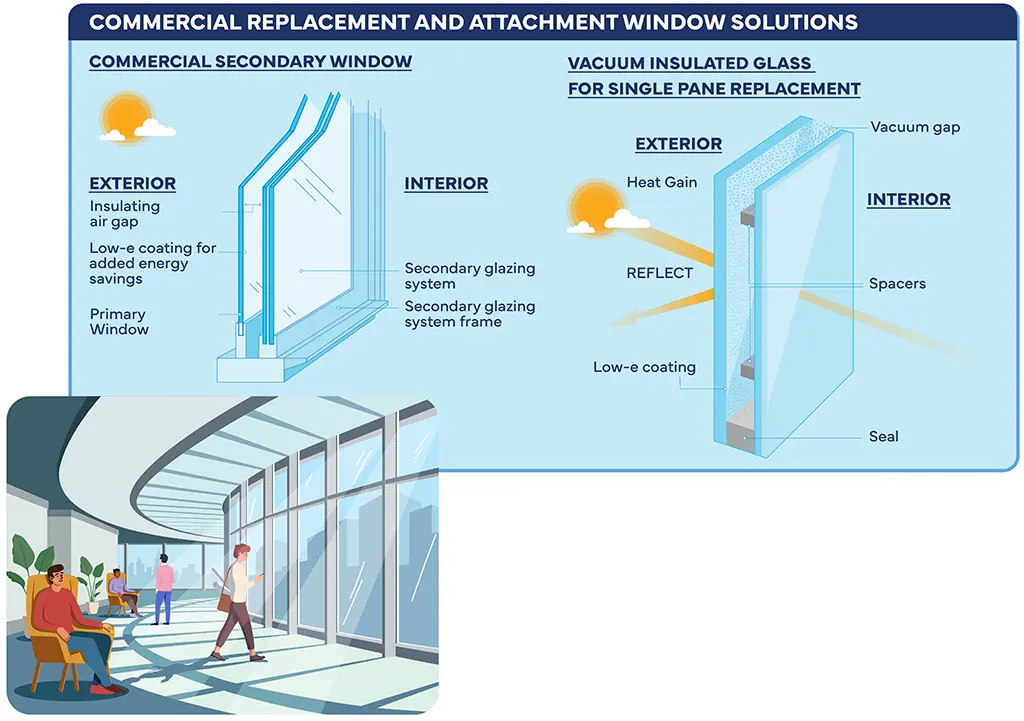

CalMTA is pursuing this potential market transformation (MT) idea to provide a lower cost option to traditional window replacement and transform the market for these more affordable, energy-saving technologies. Some barriers to that transformation include a general lack of awareness about VIG and CSW technologies, as well as a lack of policy and industry infrastructure to support an “envelope first” approach. Our strategic interventions to overcome these barriers include building marketing tools and resources that communicate the importance of taking an “envelope first” approach when working on existing commercial buildings as well as engaging with and building awareness of national energy rating mechanisms, such as Attachments Energy Rating Council (AERC) for CSW and the National Fenestration Rating Council (NFRC) for VIG.
This MT idea will target buildings from the MUSH markets in environmental and social justice (ESJ) communities with both CSW and VIG as they try to decarbonize. Because CSW are a more affordable product, CalMTA also sees a specific opportunity to target small commercial buildings, more commonly owned by ESJ community members, with CSW.
We envision a future in which over 25% of the existing commercial building sector square footage that currently have single-pane windows will utilize the window technologies of VIG or CSW by 2045 and commercial building owners will value the business benefits of taking an “envelope first” approach.

The CRAWS market transformation idea is currently in Phase II: Program Development.
Watch Rick Dunn, Sr. Manager, Emerging Technology, discuss the draft Advancement Plan and Strategy Pilot for the Commercial Replacement & Attachment Window Solutions Market Transformation Initiative at the Jun. 14, 2024 Market Transformation Advisory Board meeting.
This Advancement Plan summarizes available information and essential research activities for the proposed Commercial Replacement and Attachment Window Solutions (CRAWS) Market Transformation Initiative (MTI). It represents the Phase I stage gate deliverable describing the scope of work for research, testing, and stakeholder engagement that will be needed during Phase II
The Commercial Replacement and Attachment Window Solutions fact sheet describes the opportunity, technology, market transformation strategy and equity considerations for this initiative. Window upgrades in existing buildings offer a significant opportunity to improve building envelope thermal performance, reduce heating, ventilation, and air conditioning (HVAC) loads, and enable downsizing of HVAC

The California Market Transformation Administrator (CalMTA) develops and manages market transformation initiatives in the state to reduce energy use and reduce greenhouse gas (GHG) emissions.


CalMTA follows a rigorous process for reviewing, scoring, and then developing relevant, timely market transformation initiatives. The process supports market transformation initiative creation from concept to program development to market deployment, as well as the eventual exiting of the market.

Learn more about CalMTA’s planning and research on energy efficient technologies and our work to build California’s market transformation portfolio, and access quarterly and annual progress reports.
Want to learn more? Join our mailing list to stay informed about upcoming meetings and events, RFI and RFP announcements, and more.
We welcome your questions and suggestions.
Have questions or comments about CalMTA?
Use our contact form to connect with us, or reach out to:
CalMTA
Resource Innovations
719 Main Street, Suite A
Half Moon Bay, CA, 94019
(888) 217-0217
All Advisory Board meetings are open for public comment. If you’re unable to share your thoughts during an MTAB meeting, access our comment form to to provide your opinion.
Want to learn more? Sign up for our mailing list to receive twice-monthly updates about upcoming events, including Advisory Board meetings, informational webinars, important RFI deadlines, and more.